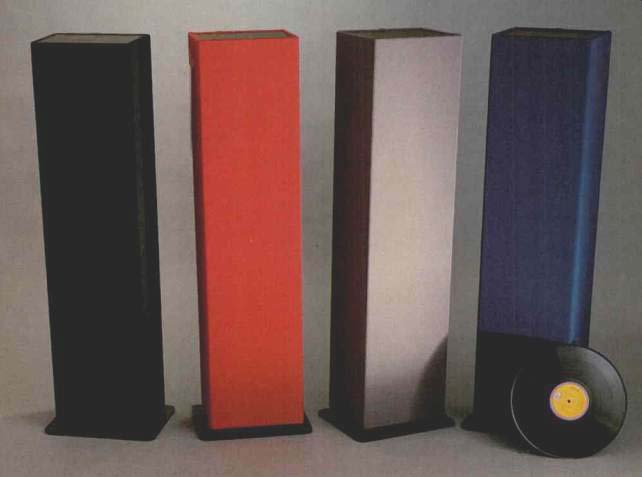
Manufacturer's Specifications:
Impedance: 6 ohms nominal, 4.5 ohms minimum.
Drivers: Two 6 1/2-in. (165-mm) mid/ bass and 1-in. (25-mm) soft dome tweeter.
Frequency Response: 41 Hz to 19.5 kHz, ±3 dB.
Crossover: 25 kHz, variable slope.
Sensitivity: 87 dB at 1 watt/1 meter.
Dimensions: 40 in. (101.2 cm) H x 10 in. (25.3 cm) W x 8 in. (20.2 cm)
D. Weight: 35 lbs. (15.9 kg).
Finish: Optional; six tops and 15 colors of grille cloth.
Price: $750.00 per pair; optional stands, $60.00 per pair.
The Night is a floor-standing loudspeaker system manufactured by Black Acoustics in Costa Mesa, Cal. Standing slightly over a meter in height, this attractive tower contains two 6 1/2-inch (165-mm) mid/bass drivers and a one-inch (25-mm) soft dome tweeter.
The low-frequency enclosure is described by Black Acoustics as a "quasi-transmission ducted vent" consisting of dual ducts for both upper and lower bass chambers. And although identical 165-mm drivers are used, they are treated with different thermoplastics which serve to dampen the mid frequencies on the lower driver while the top driver has extended highs. Both mid/bass drivers are treated with magnetic damping fluid to increase power handling capability.

An unusual aspect of the enclosure design is the use of a tight fitting, doubleknit polyester grille which covers all four sides and is called, what else, Blacksox. The Blacksox can be removed and washed if necessary, and 15 different color fabrics are available should a change be desired. The speakers, as originally delivered, did not include the stabilizing platforms, though I did subsequently receive them, and they are now listed as an optional item. These platforms are important because the unassisted Night column speaker is definitely unstable and, if placed on a thickly carpeted floor, can easily be tipped over.
The physical aspects of the enclosure are simplicity itself. A recessed rear panel houses a protective fuse and banana plug terminals for electrical connections. Double banana plugs are provided, and an excellently detailed owner's manual explains not only the proper manner of electrical connection but virtually all aspects of proper care and use of the loudspeaker system. I only wish that most loudspeaker manufacturers would supply an owner's manual that is as complete and helpful as this one. Warranty is seven years in length and is the limited type.
Measurements
The terminal impedance for the Night loudspeaker is plotted in Fig. 1; its complex impedance is plotted in Fig. 2. On average, the impedance of the Night is moderately low, dropping below 5 ohms at 20 Hz, 200 Hz and 8 kHz. The substantial excursion in upper register impedance, from 17 ohms at 2.2 kHz to 4.6 ohms at 8 kHz, dictates the use of low-impedance hookup wire in order to minimize changes in frequency response due to line loss. A worst-case amplifier load occurs at 5 kHz with a 38° capacitive reactance angle and impedance of 6 ohms. High-quality power amplifiers should be used with this speaker.
The one-meter axial anechoic frequency response is plotted in Figs. 3 and 4. Response extends uniformly from a low bass cutoff of 60 Hz to a midband driver transition at around 1 kHz. Variations in axial response above 1 kHz are due to small arrival time differences between midrange and tweeter drivers. Relative sonic efficiency is quite high, and a drive level of 8 volts peak-to-peak, which would produce 1 average watt into 8 ohms, results in an average sound pressure level near 90 dB.

Fig. 1--Magnitude of terminal impedance.
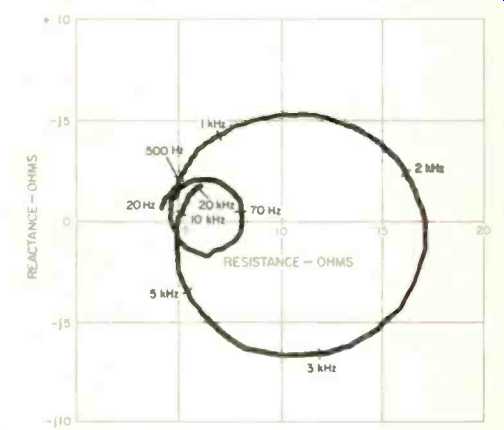
Fig. 2--Complex impedance plot.
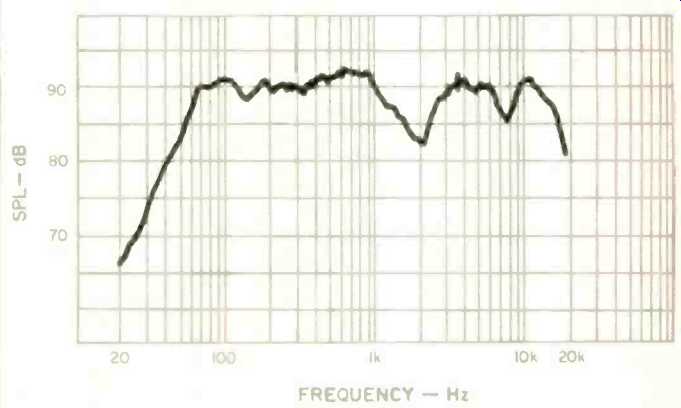
Fig. 3--One-meter anechoic axial sound pressure amplitude response with constant
voltage drive corresponding to 1 average watt into 8 ohms.
The phase response, Fig. 4, is corrected for an air-path time delay of 3.2480 mS. This shows that midrange sound arrives slightly before the sound from the tweeter, and accounts for the phase shift pattern from 1 to 3 kHz. Polarity convention for this measurement caused the speaker's white terminal to be considered positive.
The three-meter room response is more indicative of perceived timbral balance in a typical listening environment. The three-meter response, Fig. 5, is shown for two cases, one in which the listener is seated directly in front of the speaker, and the other in which the speaker occupies a conventional left-channel-stereo location relative to the listener. The Night speaker was positioned 50 centimeters in front of a wall for this measurement and the response includes only the first 11 mS of direct and early reflected sound. This measurement indicates that room response is slightly colored by early reflections from the floor and ceiling. While overall spectral balance is maintained, this measured data implies a timbre change with movement from one listening position to another.
Horizontal polar energy response is shown in Fig. 6, while the vertical response is plotted in Fig. 7. There is some overall horizontal confinement of sound, and best balance should be obtained when listening within 15° of the frontal axis position. I recommend rotating the Night loudspeaker toward the listening position for best balance of sound. The vertical dispersion is sufficiently large to indicate that the Night should be positioned away from projecting shelves and similar objects which could reflect early sound back toward the listening area. On average, the polar response shows that this speaker can maintain a respectable balanced stereo illusion with good lateralization.
Harmonic distortion for tones of E1, A2, and A4 is shown in Fig. 8. The midbass and upper registers are respectably clean up to drive powers of 100 average watts. During this test I also searched for the upper register harshness which was noticed in the earlier listening tests. Examination by means of a Fast Fourier Transform (FFT) analyzer on tones up to 10 kHz failed to disclose any apparent acoustic problem or to account for the harshness which I had heard. The bass response, however, shows distress at drive levels above 10 average watts, and the Night should not be driven to such robust levels on low bass (41 Hz) material.
IM distortion on 440 Hz (A4) due to 41 Hz (E1), when both are mixed in equal portion, is plotted in Fig. 9. Even though the acoustic harmonic distortion is high for a pure tone at 41 Hz, the intermodulation is moderately low due to this same tone. At 10 average watts the IM is only 2.02% and is composed of 6° peak-to-peak phase modulation and 3% peak-to-peak amplitude modulation. At 40 average watts the 440-Hz tone is still modulated only 6° peak-to-peak, while the amplitude modulation component has risen to approximately 10% peak-to-peak. This indicates that while deep bass may become overloaded if driven at high level with single tones, the upper register will remain relatively free of cross-modulation mud.

Fig. 4--One-meter anechoic phase response corrected for air-path delay of
3.2480 mS.
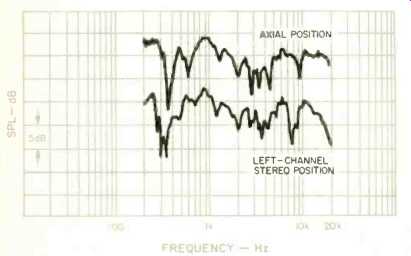
Fig. 5-Three-meter room response.
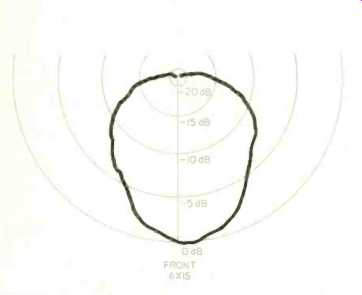
Fig. 6-Horizontal polar energy response.
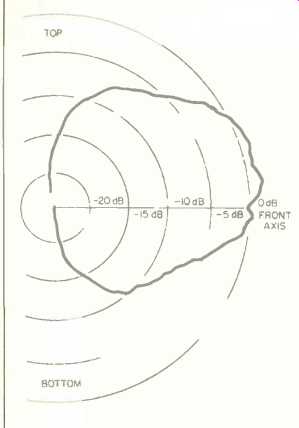
Fig. 7--Vertical polar energy response.
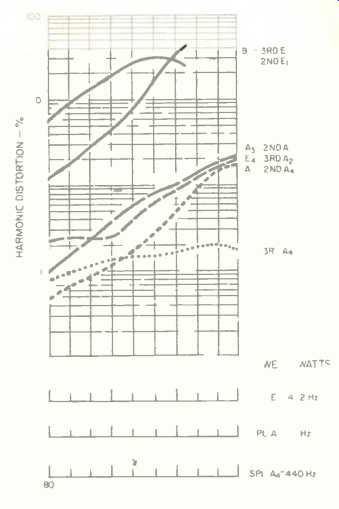
Fig. 8--Harmonic distortion for the tones E1 (41.2 Hz), A2 (110 Hz) and A4
(440 Hz).
Acoustic transfer linearity was measured at frequencies corresponding to the musical tones E1, A2 and A4. In this test, a change is made in voltage drive level and the corresponding change in acoustic output is observed. Each decibel increase in voltage should produce a corresponding decibel increase in sound pressure level. If it does not, then a distortion has occurred. At 440 Hz (A4), the Night sound pressure level follows within 0.1 dB of perfection up to 10 average watts, then drops slightly to produce a sound, at 100 average watts, which is only 0.5 dB below its proper level. At 110 Hz (A2), each decibel increase in drive voltage produces a 0.99 dB increase in sound pressure above 0.5 average watt. At 41.2 Hz (E1), each dB added in drive level produces a 1.05 dB increase in sound pressure above 0.1 average watt; this trend continues to 8 watts, then the gain rapidly drops above this power level. As a result, a musical chord composed of these tones and which is perceived with a particular timbre at 0.1 average watt will change timbre as the sound intensity increases. For example, at a sound level which should be 20 dB higher, the tone of A4 will be at the correct level, the tone of A2 will be down 0.5 dB, and the tone of E1 will be up almost a full dB.
The crescendo test measures the amount by which a weaker inner musical voice is modified by the presence of much stronger, but unrelated, musical signals. Tones of A4 and Middle C were checked with and without wideband noise which was added at average levels 20 dB above those of the pure tones. The Night fares reasonably well in the crescendo test; Middle C is uniformly reduced by 0.2 dB up to peak levels of 300 watts combined tone plus noise, while A4 is reduced less than 0.1 dB.
These two measurements, the acoustic transfer linearity and crescendo tests, infer that wideband orchestral music will undergo noticeable timbre drifts with changes in drive intensity, but little or no stereo image wander should exist within the orchestra illusion for corresponding dynamic changes.
The energy-time curve for the Night is plotted in Fig. 10. The first sound from the midrange arrives at 3.10 mS, while the first sound from the tweeter arrives at 3.2 mS for a one meter axial listening location. Subsidiary peaks at 3.33 mS and 3.45 mS are due to internal tweeter reflections. The energy cluster from 3.6 to 4.2 mS is due to later midrange and woofer arrivals. On average, the Night's impulse response is well confined and indicates a respectable response for sharp transients.
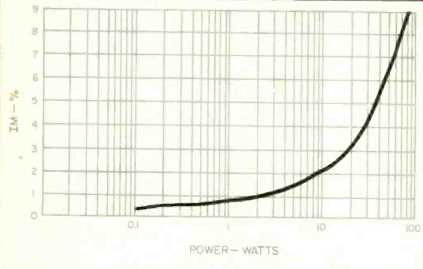
Fig. 9--Intermodulation distortion of A4 (440 Hz) by E1 (41.2 Hz) mixed
one to one.
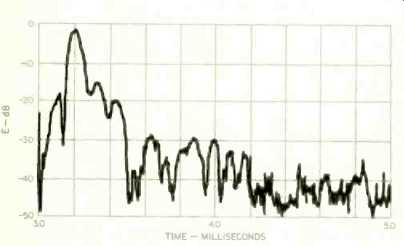
Fig. 10--Energy-time response.
Use and Listening Tests
For auditioning, the Night loudspeakers were positioned as suggested in the owner's manual. A space of 50 centimeters was allowed between the rear of the enclosures and a back wall, and the speakers were rotated inward to align the frontal axis with the listening position.

--- The Night stands tall with the often difficult to reproduce piano
sounds.
The general impression is that the midbass response is slightly dominant, although the extreme low bass is a bit weak. There is a mild spectral dominance around Middle C with a gradual roll-off of the extreme top end above about 15 kHz. To my ears I found that the best spectral balance was obtained with a mild drop in bass equalization, amounting to about 2 dB at 50 Hz, with a gradual increase in high frequency response by an amount corresponding to 3 dB at 10 kHz. This equalization improved the accuracy of both vocal and instrumental material. On average, the ability of the Night to go down to the lowest frequencies is outstripped by its capacity to go up to the highest frequencies in contemporary program material. In my opinion, the addition of a good quality subwoofer would improve sonic balance if accuracy of low bass fundamentals is desired.
This system can produce robust sound levels without audible breakup. On program peaks, I did sense a "blasty" or bright harshness in the upper midrange from 1 to 5 kHz when the system is driven hard, and there is a somewhat unclear definition of the inner musical voices in the midrange from 500 Hz to 1 kHz when reproducing at high sound levels.
Piano and female vocal are two of the most difficult types of program material to reproduce with acceptable accuracy. The Nights produced a piano sound that was well balanced, and female vocals were handled with a punchy quality often associated with some of the more popular recording studio monitor speakers. There is a decidedly vertical concentration of high-frequency sound so that the overall timbre of percussive program material was modified when a listener stood rather than sat.
Stereo lateralization is good and there is no instrumental wandering in the stereo illusion. Stereo depth is a somewhat more elusive quality than lateralization, and I was not so well satisfied with the Night's illusion of depth.
The Black Acoustics Night speakers are not physically obtrusive and can fit in well with a most any room decor, especially so if the different colored Blacksox are considered. They can be recommended for higher quality of sound reproduction in a moderately large listening space at a reasonable price.
-Richard C. Heyser
(Audio magazine, Aug. 1982)
Also see:
Boston Acoustics A40 Speaker (Equip. Profile, July 1983)
Boston Acoustics T1030 Speaker (Jan. 1991)
Avid Model 102 Speaker System (Sept. 1975)
Cambridge Physics Model 310 Loudspeaker (Nov. 1982)
= = = =